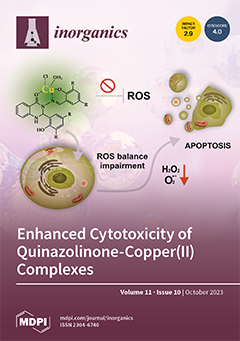Two novel silver(I) coordination polymers, [Ag(
4BP)(SCN)]
n (
1) and {(
4BPH)
+[Ag(SCN)
2]
−}
n (
2) (
4BP = 4-benzoyl pyridine), have been synthesized. The two complexes were prepared using almost the same
[...] Read more.
Two novel silver(I) coordination polymers, [Ag(
4BP)(SCN)]
n (
1) and {(
4BPH)
+[Ag(SCN)
2]
−}
n (
2) (
4BP = 4-benzoyl pyridine), have been synthesized. The two complexes were prepared using almost the same reagents, which were AgNO
3,
4BP and NH
4SCN. The only difference was the presence of 1:1 (
v/v) HNO
3 in the synthesis of
2. In the two complexes, the Ag(I) has distorted tetrahedral coordination geometry. The structure of both complexes and the involvement of the thiocyanate anion as a linker between the Ag(I) centers were confirmed using single-crystal X-ray diffraction.
4BP participated as a monodentate ligand in the coordination sphere of complex
1, while in
2 it is found protonated (
4BP-H)
+ and acts as a counter ion, which balances the charge of the anionic [Ag(SCN)
2]
− moiety. The thiocyanate anion shows different coordination modes in the two complexes. In complex
1, the thiocyanate anion exhibits a
µ1,1,3 bridging mode, which binds three Ag(I) ions to build a boat-like ten-membered ring structure leading to a two-dimensional coordination polymer. In
2, there are mixed
µ1,1 and
µ1,3 bridging thiocyanate groups, which form the one-dimensional polymeric chain running in the
a-direction. Several interactions affected the stability of the crystal structure of the two complexes. These interactions were examined using Hirshfeld surface analysis. The coordination interactions (Ag-S and Ag-N) have a great impact on the stability of the polymeric structure of the two complexes. Additionally, the hydrogen-bonding interactions are crucial in the assembly of these coordination polymers. The O…H (10.7%) and C…H (34.2%) contacts in
1 as well as the N···H (15.3%) and S···H (14.9%) contacts in
2 are the most significant. Moreover, the argentophilic interaction (Ag…Ag = 3.378 Å) and π- π stacking play an important role in the assembly of complex
2.
Full article





